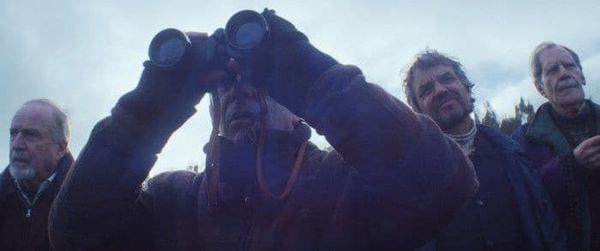Eye For Film >> Movies >> The Club (2015) Film Review
The Club
Reviewed by: Owen Van Spall

Pablo Larraín's The Club is a sinister, searing indictment of the Catholic Church and its hypocrisy. Yet the director, as with his previous films which have explored the past few decades of Chilean experience (Tony Manero, Post Mortem, No), avoids going for the immediate and heavy-handed knock-out blow. Instead, he relies on a gradual pace, a blackly comedic tone and well-crafted scenarios of banal cruelty and pettiness to critique how institutions, and the people within them, justify their own actions to themselves and others.
There are few initial clues that the four men introduced in The Club's opening scenes are priests. The setting is a small seaside monastery atop a gentle incline, overlooking the town, where four men of various ages potter about attended to by a fastidious matron. We see these middle-aged and elderly men mostly just watching TV, strolling along the beach or wandering around. They also have a hobby in placing bets on the local greyhound races, or, to be more precise, having their matron take their prize running dog down to the track for them, while they watch with binoculars. This low-level gambling by this gang of misanthropes is comedic but also unsettling, as the way the men are careful to distance themselves from the general population is the first time we sense something is different, wrong even, about them.

Suspicions are confirmed when Chilean Father Lazcano (José Soza) suddenly comes to join them. A nervous, quiet man, Lazcano is evasive as to why he has come. Barely has the newcomer settled in than a drunk, deranged local man appears outside the monastery, shouting that he was molested as a child by this newest member of The Club. There is hardly time for viewers to process this new angle however, as Lazcano promptly commits suicide courtesy of a gun that the other residents - now revealed as other priests - somehow have kept handy. Lazcano’s death is the catalyst for an insightful and haunting demonstration of how the club operates as a microcosm of the Catholic Church’s darker impulses to police and protect itself. The process begins when the Church, fearing a scandal, sends pious young Father Garcia (Marcelo Alonso, who is mockingly referred to as “one of those new priests”) to interrogate and counsel the fallen Fathers and possibly close The Club down to avoid further scandal. But any hope that this new priest can clean house is swiftly disabused.
As Garcia talks to the men - Fathers Vidal (Larraín regular Alfredo Castro), Silva (Jaime Vadell), Ortega (Alejandro Goic), and Ramirez (Alejandro Sieveking) - their various transgressions are revealed. Varied though their offences were, and though each man reacts differently to the probing, what unites them all is a sense of moral righteousness and a sort of victim complex. Each has found a way to justify themselves via their faith, whether it be concealing military crimes or taboo sexual urges. Yet the cast and script never make them any less than totally, pathetically believable. Despite being in a form of excommunication, the priests seem to instinctively rally round each other to conceal exactly what happened, gathering in little whispering enclaves and agreeing the line they will take with Garcia. The self-preservation instinct of the Church is alive and well out here, even if much of the anger is directed at Garcia’s denial of their petty pleasures, such as good wine, and racing the dogs for money.
Perhaps the strangest figure in all this though is the matron; the permissive Sister Monica (Antonia Zegers). Despite having a face fixed permanently in a wide-eyed, innocent mask, over time she gives off more and more of the impression that she is really the one who knows where all the skeletons are buried. Soon Father Garcia is himself put in a compromised situation. Desperate to protect the Church and/or his own reputation, Garcia finds himself complicit in the terrible repercussions that occur when the abused man returns, defiantly positioning himself outside their front door and threatening to disrupt the harmony forever.
Larraín and director of photography Sergio Armstrong go for a striking, muted and foggy colour pallette; the interior of the chateau seems always gloomy despite the vivid outside light, giving the sense that this is a place where there is a desire to keep the light of discovery out. It really gives the impression of men living at the edge of the continent — and far beyond the moral boundaries of their faith. The bizarre range of characters and events, and the way dark humour is twisted tightly into the narrative, do not detract from the seriousness of the questions raised by the film, in fact they give the proceedings more punch. The banality only makes the sinners in the club more tragically human, stripping them utterly of the last vestiges of the cloth’s grace. A powerful, essential film that confirms Larraín as a master filmmaker.
Reviewed on: 08 Oct 2015

















